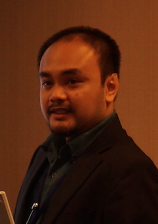Recent Advances in Gravitational Search Algorithm

Associate Professor Dr. Zuwairie Ibrahim, Universiti Malaysia Pahang
Synopsis
The latest advancement of Gravitational Search Algorithm (GSA) will be presented. GSA is one of the recent population-based metaheuristic algorithm inspired by physical phenomenon of Newtonian gravity and motion. In GSA, each agent is given its own mass influenced by its fitness value. The masses are then used to calculate the attraction force of an agent towards another. Using the law of motion, the acceleration of an agent can be determined to update the agents velocity and position.
This lecture is divided into three main topics:
GSA is not purely based on the Law of Motion
The popularity of GSA in fundamental studies and applications is growing. However, most of the researchers have not realize that GSA itself is not purely based on the Law of Motion. This issue will be explained in detail and a version of GSA that is exactly follows the Newtonian gravity and motion will be introduced.
Multi-State GSA
A new version of GSA for discrete optimization problem called multi-state GSA (MSGSA) is introduced. The MSGSA works based on a simplified mechanism of transition between two states. Experimental results will be showed to prove the effectiveness of the newly introduced approach, regarding its ability to consistently outperforms the binary-based algorithms in solving the discrete optimization problem.
Synchronous and Asynchronous GSA
Originally, GSA was introduced as a synchronous update algorithm, where the agents’ velocity and position are updated after the whole population performance is evaluated. Asynchronous update in GSA has been studied recently. An agent in asynchronous GSA (A-GSA) updates its velocity and position immediately after its own performance is evaluated. In this lecture, an attempt to further improve the performance of GSA by merging both synchronous and asynchronous update in the search process will be presented.
Biography
Associate Professor Dr. Zuwairie Ibrahim obtained a B.Eng (Mechatronics) and M.Eng (Electrical) from Universiti Teknologi Malaysia, and Ph.D in Electrical Engineering from Meiji University, Japan. He is currently Associate Professor of Faculty of Electrical and Electronics Engineering, Universiti Malaysia Pahang. His research interests are on Computational Intelligence, Artificial Intelligence, Molecular and DNA Computing, Machine Vision and Automated Visual Inspection. He has supervised 7 postgraduate students and currently supervising 6 PhD and 2 Master students. He has received various funding from both local and international bodies, as well as holding 3 patents. He has published articles in 2 books, 76 journal articles and many conference proceedings. He is also involved in consultations, the editorial board of local and international journals and has reviewed many technical papers. He received awards of the Best Instrumentation Paper Award in International Conference on Control, Instrumentation, and Mechatronics Engineering 2007, Session Best Presentation Award in Joint 2nd International Conference on Soft Computing and Intelligent Systems and 5th International Symposium on Advanced Intelligent Systems 2004 and Student paper award in the IEEE International Symposium on Industrial Electronics 2004. He has also won several medals in various research exhibitions and has been invited to give lectures and tutorials in his research fields. He is a member of IEEE, BEM and mSET.

